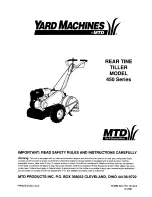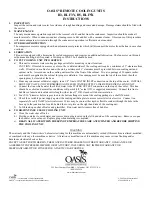
5.5 Water pipe installation
NOTE
■ If there is no glycol (anti-freeze) in the system there is a power
supply or pump failure, drain the system (as shown in the
figure below).
WARNING
A
<A
When water is not moving inside the system in
cold weather, freezing is very likely and will
damage the system.
5.5.1 Water quality control
1 Water quality control
When industrial water is used as chilled water, little furring may
occur; however, well water or river water, used as chilled water,
may cause much sediment, such as furring, sand, and so on.
Therefore, well water or river water must be filtered and softened
in softening water equipment before flowing into chilled water
system. If sand and clay settle in the evaporator, circulation of
chilled water may be blocked, and thus leading to freezing
accidents; if hardness of chilled water is too high, furring may
occur easily, and the devices may be corroded. Therefore, the
quality of chilled water should be analysed before being used,
such as PH value, conductivity, concentration of chloride ion,
concentration of sulphide ion, and so on.
2 Applicable standard of water quality for the unit
PH value
6
~
8
Total hardness
<50ppm
Conductivity
<200μV/cm
(25℃)
Sulfide ion
No
Chloride ion
<50ppm
Ammonia ion
No
Sulfate ion
<50ppm
Silicon
<30ppm
Iron content
<0.3ppm
Sodium ion
No requirement
Calcium ion
<50ppm
5.5.2 Checking the water circuit
The units are equipped with a water inlet and outlet for connection to
a water circuit. This circuit must be provided by a licensed technician
and must comply with local laws and regulations.
The unit is only to be used in a closed water system.
Application in an open water circuit can lead to excessive
corrosion of the water piping.
Before continuing installation of the unit, check the following:
■ The maximum water pressure can not exceed 3 bar.
■ The maximum water temperature is 60°C according to safety
device setting.
■ Always use materials that are compatible with the water used in the
system and with the materials used in the unit.
■ Ensure that components installed in the field piping can withstand
the water pressure and temperature.
■ Drain taps must be provided at all low points of the system to
permit complete drainage of the circuit during maintenance.
■ Air vents must be provided at all high points of the system. The
vents should be located at points that are easily accessible for
servicing. An automatic air purge is provided inside the unit. Check
that this air purge valve is not tightened too much so that
automatic release of air in the water circuit remains possible.
5.5.3 Checking the water volume and expansion vessel
pre-pressure
The unit is equipped with expansion vessel that has a
default pre-pressure of 1.5 bar.
To assure proper operation of the unit, the pre-pressure of the
expansion vessel might need to be adjusted and the minimum
and maximum water volume must be checked.
1. Check that the total water volume in the installation, excluding
the internal water volume of the unit, is at least 20L. Refer to 14
Technical specifications to find the total internal water volume of
the unit.
NOTE
■ In most applications this minimum water volume will
be satisfactory.
■ In critical processes or in rooms with a high heat load
though, extra water might be required.
■ When circulation in each space heating loop is controlled by
remotely controlled valves, it is important that this minimum water
volume is kept even if all the valves are closed.
2. Using the table below, determine if the expansion vessel
pre- pressure requires adjustment.
3. Using the table and instructions below, determine if the total
water volume in the installation is below the maximum allowed
water volume.
Installation
Water volume
height
5/7kW
≤
58 L
5/7kW
>
58 L
difference
(a)
10~16kW
≤
88 L
10~16kW
>
88 L
Actions required:
• pre-pressure must be decreased,
calculate according to "Calculating
≤7 m
No pre-pressure adjustment
the pre-pressure of the expansion
vessel"
required.
• check if the water volume is lower
than maximum allowed water
volume (use graph below)
Actions required:
• Pre-pressure must be increased,
calculate according to "Calculating
>7 m
the pre-pressure of the expansion
Expansion vessel of
the unit too
vessel" below.
small for the installation.
•
Check if the water volume is lower
than maximum allowed water
volume (use graph below)
(a) Installation height difference: height difference (m) between the
highest point of the water circuit and the unit. If the unit is located
at the highest point of the installation, the installation height
should be 0 m.
Calculating pre-pressure of the expansion vessel
The pre-pressure (Pg) to be set depends on the maximum installation
height difference (H) and is calculated as follows:
Pg(bar)=(H(m)/10+0.3) bar
Checking the maximum allowed water volume
To determine the maximum allowed water volume in the entire circuit,
proceed as follows:
1. Determine the calculated pre-pressure (Pg) for the
corresponding maximum water volume using the graph below.
20
















































